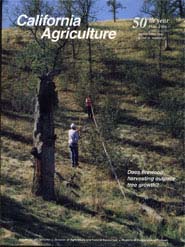


University of California
California Agriculture



|
|||
|
|||

Does firewood harvesting outpace tree growth?
Cover:
UC researchers monitor regeneration and stand structure in Tehama County to determine if tree growth has outpaced firewood harvest. Photo by Richard Standiford
March-April 1996
Volume 50, Number 2 |
|||
|
University of California, 1301 S. 46th St., Bldg. 478 Richmond, CA
|